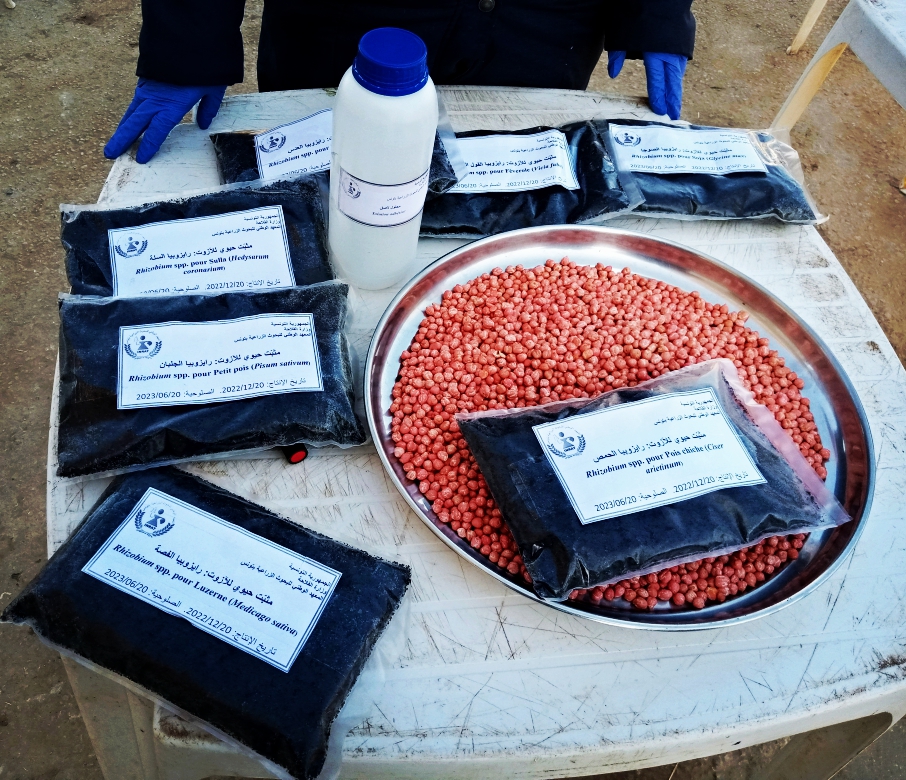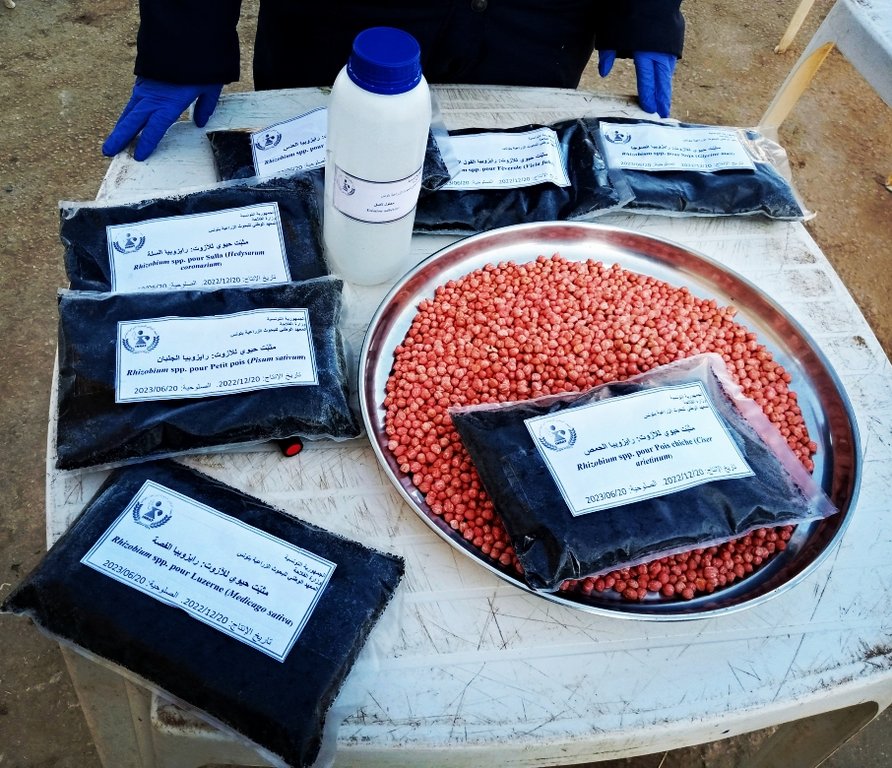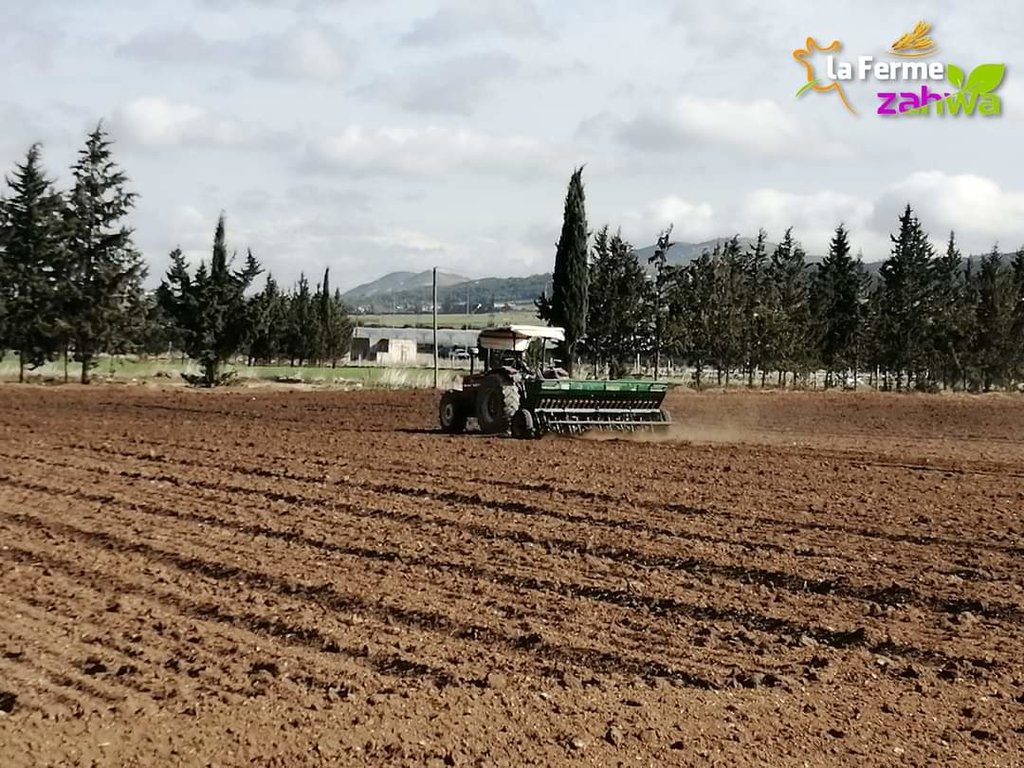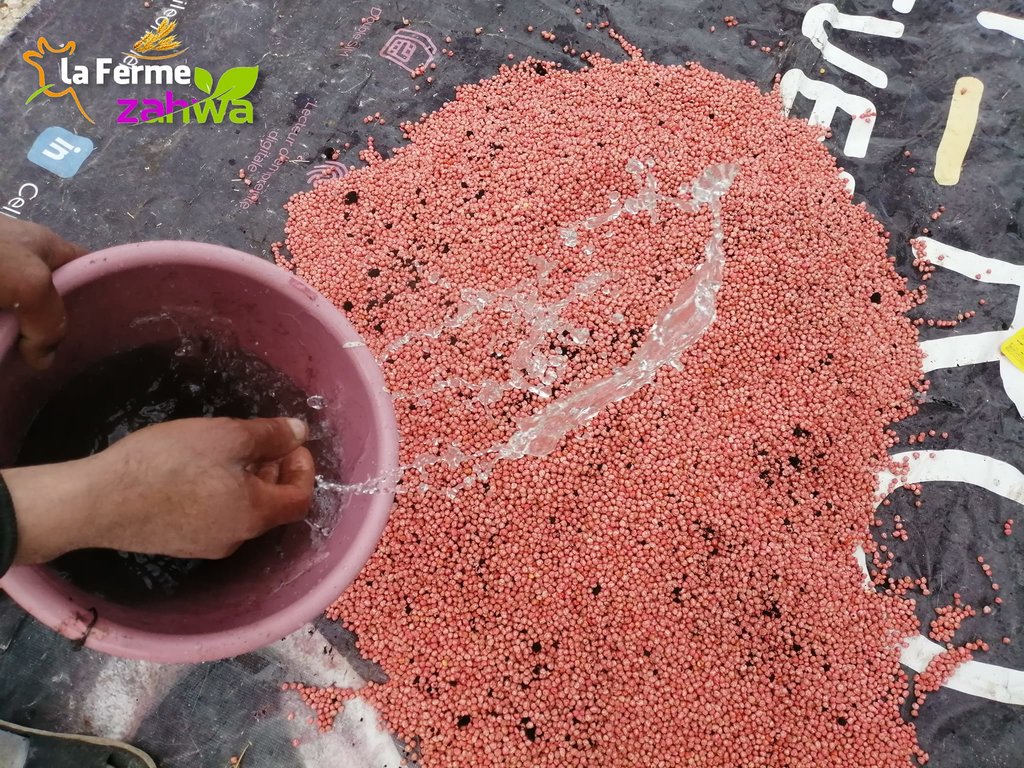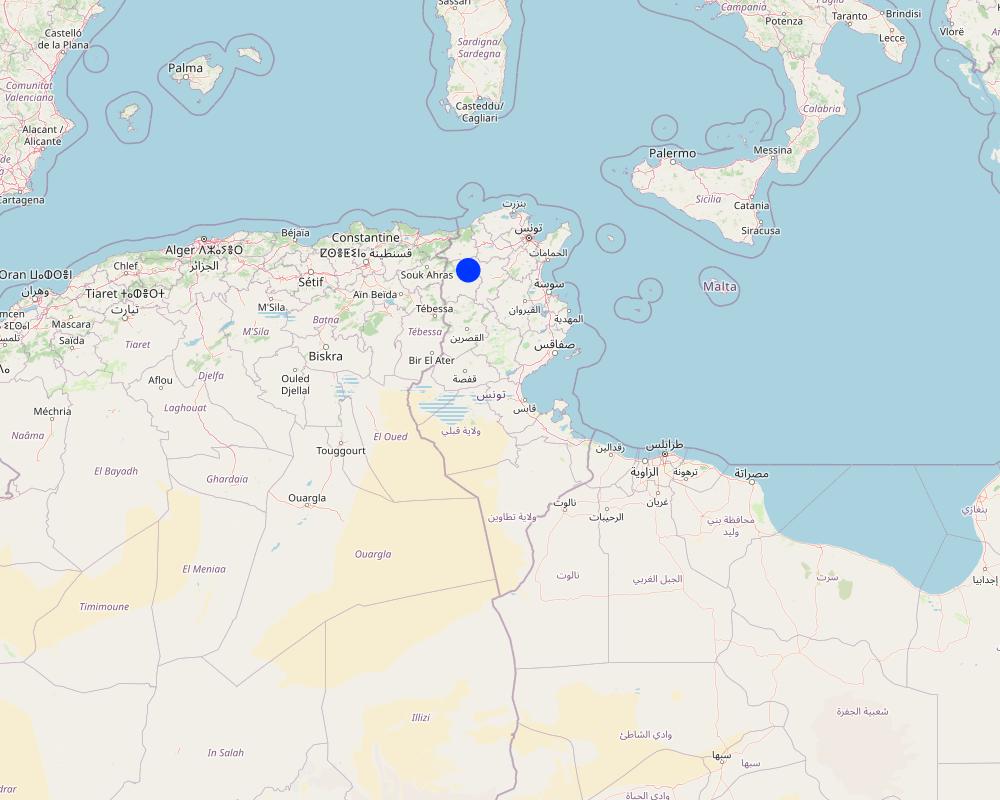Fertilisation raisonnée [Tunisia]
- Creation:
- Update:
- Compiler: Wafa Saidi
- Editors: Siagbé Golli, Faouzi Harrouchi, faouzi BATTI, Fatma Maaloul
- Reviewers: William Critchley, Rima Mekdaschi Studer
technologies_6678 - Tunisia
View sections
Expand all Collapse all1. General information
1.2 Contact details of resource persons and institutions involved in the assessment and documentation of the Technology
Key resource person(s)
SLM specialist:
HLEL Dorsaf
Institut National Des Grandes Cultures
Tunisia
SLM specialist:
HEMISSI Imen
Institut National de la Recherche Agronomique de Tunisie
Tunisia
SLM specialist:
1.3 Conditions regarding the use of data documented through WOCAT
The compiler and key resource person(s) accept the conditions regarding the use of data documented through WOCAT:
Yes
1.4 Declaration on sustainability of the described Technology
Is the Technology described here problematic with regard to land degradation, so that it cannot be declared a sustainable land management technology?
No
2. Description of the SLM Technology
2.1 Short description of the Technology
Definition of the Technology:
Le recours à l’agriculture à faible intrants par le biais de l’utilisation des microorganismes symbiotiques permet le maintien de la production et la préservation de l’environnement. En effet, l’inoculation avec les bactéries (Rhizobium) contribue à l’amélioration de la productivité des légumineuses et la qualité de la récolte.
2.2 Detailed description of the Technology
Description:
L’inoculum rhizobial est un produit naturel et biologique, facile à appliquer, moins cher que les produits chimiques et possède une action qui dure dans le sol sur plusieurs années. En Tunisie, l’inoculation des légumineuses par Rhizobium a été pratiquée dans différentes zones agro-climatiques à climats sub-humide, semi-aride supérieur, semi-aride et aride supérieur. Les sols étaient à majorité caractérisés par un pH légèrement basique, une teneur élevée en calcaire actif et faible en matière organique, des sols peu profonds et sensibles à l’érosion hydrique et éolienne.
Cette pratique permet d’apporter des éléments nutritifs aux légumineuses (haricot, fève, pois chiche, lentille...etc) et ainsi d’améliorer leur croissance, rendement et résistance aux maladies et effets néfastes du changement climatique. Elle permet aussi d’améliorer la fertilité du sol via la stimulation de la biomasse microbienne des sols contribuant à leur résilience face à l’érosion et la dégradation. Utilisées en rotation dans les systèmes de cultures céréaliers, les légumineuses possèdent la particularité de former des associations symbiotiques avec des bactéries du sol (Rhizobium).
L’inoculation devient nécessaire lorsque les populations bactériennes autochtones spécifiques sont absentes, en nombre insuffisant, ou non efficientes. Une fois l’isolement des souches de Rhizobium efficientes désirées selon l’espèce à cultiver est fait à partir des nodules racinaires, les bactéries pures sont multipliées et ensemencées dans un substrat stérile (tourbe) dans des sacs de 400 grammes préparés aseptiquement au laboratoire de l’Institut National de la Recherche Agronomique de Tunisie chargé de produire et commercialiser ces biofertilisants. Au niveau de la parcelle, chez l’agriculteur, la technique d’inoculation consiste à enrober les semences, juste avant le semis avec l’inoculum afin d’introduire les souches de rhizobium dans l’écosystème plante-sol. Avec l’inoculum on utilise un adhésif qui sert à coller le Rhizobium aux semences et aussi à l’alimenter jusqu’à ce qu’il infecte la plante. L’opération d’enrobage des semences se fait dans un endroit ombragé, pour un semis dans les heures qui suivent. Ainsi, le semi peut être effectué à l’aide d’un semoir automatique ou semi-automatique en mélange avec la fumure de fond.
Les rhizobia sont sensibles à différents stress abiotiques, notamment la sècheresse et la température élevée qui agissent négativement sur leur efficience et survie. Pour cela, une à deux irrigations complémentaires sont nécessaires en cas d’absence de pluie. Enfin, l’agriculteur doit respecter les bonnes pratiques de gestion des terres comme la rotation, l’association des cultures, la fertilisation raisonnée, … afin de maintenir la durabilité de l’effet de l’inoculation.
Les impacts de l’inoculation des légumineuses par Rhizobium sont un sol sain et fertile, des cultures productives, des systèmes de cultures plus résilients face aux changements climatiques et une production céréalière durable assurant la sécurité alimentaire.
Plusieurs agriculteurs de différentes régions ont utilisé le biofertilisant et sont convaincus par son efficacité sur leurs sols et cultures.
2.3 Photos of the Technology
2.5 Country/ region/ locations where the Technology has been applied and which are covered by this assessment
Country:
Tunisia
Region/ State/ Province:
Sidi Bouzid
Further specification of location:
Borj El Ifa
Specify the spread of the Technology:
- applied at specific points/ concentrated on a small area
Is/are the technology site(s) located in a permanently protected area?
No
If yes, specify:
Une ferme sécurisée
Comments:
une ferme sécurisée
Map
×2.6 Date of implementation
If precise year is not known, indicate approximate date:
- less than 10 years ago (recently)
2.7 Introduction of the Technology
Specify how the Technology was introduced:
- during experiments/ research
- through projects/ external interventions
3. Classification of the SLM Technology
3.1 Main purpose(s) of the Technology
- reduce, prevent, restore land degradation
- conserve ecosystem
- preserve/ improve biodiversity
- mitigate climate change and its impacts
- create beneficial economic impact
3.2 Current land use type(s) where the Technology is applied
Land use mixed within the same land unit:
No

Cropland
- Annual cropping
- Tree and shrub cropping
Annual cropping - Specify crops:
- fodder crops - grasses
- cereals - maize
- cereals - barley
- legumes and pulses - peas
Annual cropping system:
Fallow - maize/sorghum/millet intercropped with legume
Tree and shrub cropping - Specify crops:
- pome fruits (apples, pears, quinces, etc.)
- olive
Number of growing seasons per year:
- 1
Is intercropping practiced?
Yes
Is crop rotation practiced?
Yes

Grazing land
Extensive grazing:
- Ranching
Animal type:
- cattle - dairy
- sheep
Is integrated crop-livestock management practiced?
Yes
Products and services:
- milk
- meat
Species:
cattle - dairy
Count:
28
Species:
sheep
Count:
15

Settlements, infrastructure
- Settlements, buildings
- Energy: pipelines, power lines
3.3 Has land use changed due to the implementation of the Technology?
Has land use changed due to the implementation of the Technology?
- No (Continue with question 3.4)
3.4 Water supply
Water supply for the land on which the Technology is applied:
- mixed rainfed-irrigated
3.5 SLM group to which the Technology belongs
- rotational systems (crop rotation, fallows, shifting cultivation)
- integrated soil fertility management
- integrated pest and disease management (incl. organic agriculture)
3.6 SLM measures comprising the Technology

agronomic measures
- A2: Organic matter/ soil fertility
- A5: Seed management, improved varieties

management measures
- M2: Change of management/ intensity level
3.7 Main types of land degradation addressed by the Technology

chemical soil deterioration
- Cn: fertility decline and reduced organic matter content (not caused by erosion)
- Cp: soil pollution

physical soil deterioration
- Pc: compaction
- Pu: loss of bio-productive function due to other activities

biological degradation
- Bc: reduction of vegetation cover
- Bq: quantity/ biomass decline
- Bs: quality and species composition/ diversity decline
- Bl: loss of soil life
- Bp: increase of pests/ diseases, loss of predators
3.8 Prevention, reduction, or restoration of land degradation
Specify the goal of the Technology with regard to land degradation:
- prevent land degradation
- reduce land degradation
4. Technical specifications, implementation activities, inputs, and costs
4.1 Technical drawing of the Technology
Technical specifications (related to technical drawing):
Les specifications techniques sont
au laboratoire:
- isolement des bacteries en fonction de la legumineuse;
- preparation des sacs de 400 g aseptiquement;
- multiplication et ensemencement dans la tourbe dans les sacs.
Au niveau de la parcelle
-
-
-
Author:
Hanen Arfaoui, Amira Hachana et Imen Hemissi (INRAT)
Date:
05/2023
4.2 General information regarding the calculation of inputs and costs
Specify how costs and inputs were calculated:
- per Technology area
Indicate size and area unit:
1 ha
other/ national currency (specify):
Dinar tunisien
If relevant, indicate exchange rate from USD to local currency (e.g. 1 USD = 79.9 Brazilian Real): 1 USD =:
3.1
Indicate average wage cost of hired labour per day:
25
4.3 Establishment activities
| Activity | Timing (season) | |
|---|---|---|
| 1. | Labour | Mi-octobre à début novembre |
| 2. | Préparation lit de semis | Mi-octobre à début novembre |
| 3. | Préparation des semences | Décembre (le jour de semi) |
| 4. | Désherbage pré-semis (trifluraline) | Décembre |
| 5. | Semis | Décembre |
| 6. | Ajout de DAP (50 Kg/ha) |
4.4 Costs and inputs needed for establishment
If you are unable to break down the costs in the table above, give an estimation of the total costs of establishing the Technology:
500.0
If land user bore less than 100% of costs, indicate who covered the remaining costs:
INGC/projet PROSOL
Comments:
Dans le cadre du projet ProSOL, les semences sont mises à la disposition des agriculteurs gratuitement.
4.5 Maintenance/ recurrent activities
| Activity | Timing/ frequency | |
|---|---|---|
| 1. | Irrigation après semis (au cas d'absence ou retard de la pluie) | |
| 2. | Désherbage post semis (Simazine) | avant levé |
| 3. | Traitement fongique (Anthracnose et Botrytis) | Selon l'apparaissiant des symptômes |
| 4. | Traitement insecticide (Puceron) | Selon l'apparaissiant des symptômes |
5. Natural and human environment
5.1 Climate
Annual rainfall
- < 250 mm
- 251-500 mm
- 501-750 mm
- 751-1,000 mm
- 1,001-1,500 mm
- 1,501-2,000 mm
- 2,001-3,000 mm
- 3,001-4,000 mm
- > 4,000 mm
Agro-climatic zone
- semi-arid
5.2 Topography
Slopes on average:
- flat (0-2%)
- gentle (3-5%)
- moderate (6-10%)
- rolling (11-15%)
- hilly (16-30%)
- steep (31-60%)
- very steep (>60%)
Landforms:
- plateau/plains
- ridges
- mountain slopes
- hill slopes
- footslopes
- valley floors
Altitudinal zone:
- 0-100 m a.s.l.
- 101-500 m a.s.l.
- 501-1,000 m a.s.l.
- 1,001-1,500 m a.s.l.
- 1,501-2,000 m a.s.l.
- 2,001-2,500 m a.s.l.
- 2,501-3,000 m a.s.l.
- 3,001-4,000 m a.s.l.
- > 4,000 m a.s.l.
5.3 Soils
Soil depth on average:
- very shallow (0-20 cm)
- shallow (21-50 cm)
- moderately deep (51-80 cm)
- deep (81-120 cm)
- very deep (> 120 cm)
Soil texture (topsoil):
- medium (loamy, silty)
Soil texture (> 20 cm below surface):
- medium (loamy, silty)
- fine/ heavy (clay)
Topsoil organic matter:
- high (>3%)
- medium (1-3%)
5.4 Water availability and quality
Ground water table:
on surface
Availability of surface water:
good
Water quality (untreated):
for agricultural use only (irrigation)
Water quality refers to:
surface water
Is water salinity a problem?
No
Is flooding of the area occurring?
No
5.5 Biodiversity
Species diversity:
- high
Habitat diversity:
- medium
Comments and further specifications on biodiversity:
Mais fourragère, production du fromage, légumineuse, Céréale, Elevage Bovin, Arboriculture
Contractualisation de la production (CMA)
5.6 Characteristics of land users applying the Technology
Sedentary or nomadic:
- Sedentary
Market orientation of production system:
- mixed (subsistence/ commercial)
Off-farm income:
- less than 10% of all income
Relative level of wealth:
- rich
Individuals or groups:
- individual/ household
Level of mechanization:
- mechanized/ motorized
Gender:
- women
- men
Age of land users:
- youth
- middle-aged
- elderly
5.7 Average area of land used by land users applying the Technology
- < 0.5 ha
- 0.5-1 ha
- 1-2 ha
- 2-5 ha
- 5-15 ha
- 15-50 ha
- 50-100 ha
- 100-500 ha
- 500-1,000 ha
- 1,000-10,000 ha
- > 10,000 ha
Is this considered small-, medium- or large-scale (referring to local context)?
- large-scale
5.8 Land ownership, land use rights, and water use rights
Land ownership:
- individual, titled
Land use rights:
- individual
Water use rights:
- individual
Are land use rights based on a traditional legal system?
No
5.9 Access to services and infrastructure
health:
- poor
- moderate
- good
education:
- poor
- moderate
- good
technical assistance:
- poor
- moderate
- good
employment (e.g. off-farm):
- poor
- moderate
- good
markets:
- poor
- moderate
- good
energy:
- poor
- moderate
- good
roads and transport:
- poor
- moderate
- good
drinking water and sanitation:
- poor
- moderate
- good
financial services:
- poor
- moderate
- good
6. Impacts and concluding statements
6.1 On-site impacts the Technology has shown
Socio-economic impacts
Production
crop production
Comments/ specify:
Une augmentation de 25 à 30 % de rendement en grain
crop quality
Comments/ specify:
Taux de protéine des graines est plus élevé
Amélioration du poids du 100 grains
risk of production failure
Income and costs
expenses on agricultural inputs
farm income
Socio-cultural impacts
food security/ self-sufficiency
SLM/ land degradation knowledge
Comments/ specify:
Des journées de sensibilisations et d'information
Ecological impacts
Soil
nutrient cycling/ recharge
soil organic matter/ below ground C
Specify assessment of on-site impacts (measurements):
L'évaluation des impacts de cette technologie est faite dans le cadre des action de recherches et sur des parcelles expérimentales.
6.2 Off-site impacts the Technology has shown
Specify assessment of off-site impacts (measurements):
Il n'y a pas des informations relatives aux impacts hors site.
6.3 Exposure and sensitivity of the Technology to gradual climate change and climate-related extremes/ disasters (as perceived by land users)
Gradual climate change
Gradual climate change
| Season | increase or decrease | How does the Technology cope with it? | |
|---|---|---|---|
| seasonal rainfall | wet/ rainy season | decrease | well |
6.4 Cost-benefit analysis
How do the benefits compare with the establishment costs (from land users’ perspective)?
Short-term returns:
very positive
Long-term returns:
very positive
How do the benefits compare with the maintenance/ recurrent costs (from land users' perspective)?
Short-term returns:
very positive
Long-term returns:
very positive
6.5 Adoption of the Technology
- 1-10%
Of all those who have adopted the Technology, how many did so spontaneously, i.e. without receiving any material incentives/ payments?
- 0-10%
6.6 Adaptation
Has the Technology been modified recently to adapt to changing conditions?
No
6.7 Strengths/ advantages/ opportunities of the Technology
| Strengths/ advantages/ opportunities in the land user’s view |
|---|
| Amélioration de la productivité |
| Diminution des intrants chimiques |
| Strengths/ advantages/ opportunities in the compiler’s or other key resource person’s view |
|---|
| Remet pour la structure du sol (amélioration de la biodiversité du sol dégradé) |
| La biodiversité des cultures par l'introduction des légumineuse dans le système agricole dans les zones à risque (climatique, biotique) |
6.8 Weaknesses/ disadvantages/ risks of the Technology and ways of overcoming them
| Weaknesses/ disadvantages/ risks in the land user’s view | How can they be overcome? |
|---|---|
| L'accès aux biofertilisants | Journées d'information auprès des agriculteurs |
| Weaknesses/ disadvantages/ risks in the compiler’s or other key resource person’s view | How can they be overcome? |
|---|---|
| L'accès aux biofertilisants n'est pas aussi commercialisés (il reste à échelle institutionnelle) | L'introduction des biofertilisants dans une chaine de production à grande échelle |
7. References and links
7.1 Methods/ sources of information
- interviews with land users
Un agriculteur a été interrogé.
- interviews with SLM specialists/ experts
3 spécialistes ont été interrogés.
- compilation from reports and other existing documentation
When were the data compiled (in the field)?
04/04/2023
7.2 References to available publications
Title, author, year, ISBN:
Effects of soil variability on the diversity of rhizobia nodulating pea (Pisum sativum L.) in Tunisia, Amira HACHANA, Imen HEMISSI, Chayma ChAMMAKHI, Amir SOUISSI, Manel BOURAOUI , Neila ABDI, Hanen ARFAOUI and Bouaziz SIFI. 2021
Available from where? Costs?
Institut National de la Recherche Agronomique de Tunisie
Title, author, year, ISBN:
Diagnostic de la diversité des souches de Rhizobium leguminosarum nodulant le pois (Pisum sativum L.) et leurs interactions avec la microflore rhizosphérique dans différentes zones bioclimatiques de la Tunisie, Amira Hachana, 2021
Available from where? Costs?
Institut National Agronomique de Tunis
Title, author, year, ISBN:
Effect of Some Rhizobium Strains on Fenugreek Growth and Biological Control of Sclerotinia Stem Rot of Fenugreek Caused by Sclerotinia trifoliorum, Hemissi Imen, Hachana Amira, Arfaoui Hanen, 2021 Acta Scientific Agriculture, Vol 5(5): 37-45. ISSN: 2581-365X
Available from where? Costs?
Institut National de la Recherche Agronomique de Tunisie
Title, author, year, ISBN:
Inoculation with phosphate solubilising Mesorhizobium strains improves chickpea (Cicer aritenium L.) growth performance under phosphorus deficiency, Hemissi Imen, Abdi Neila, Bargaz Adnane, Bouraoui Manel, Yassine Mabrouk, Mouldi Saidi and SIFI Bouaziz, 2015
Available from where? Costs?
Institut National de la Recherche Agronomique de Tunisie
7.3 Links to relevant online information
Title/ description:
Fichier technique de la fixation symbiotique de l'azote Légumineuse/ Rhizobium, FAO, 1983
URL:
https://books.google.tn/books?id=Q14_9-QKkXIC&printsec=frontcover&hl=fr&source=gbs_ge_summary_r&cad=0#v=onepage&q&f=false
Title/ description:
Études écologiques et fonctionnelles de symbioses entre rhizobia et légumineuses. Thèse de doctorat, Ala Eddine Cherni, 2019
URL:
http://archive-ouverte.unige.ch/unige:120285
Title/ description:
Etude du potentiel bénéfique des souches de Rhizobium pour Medicago truncatula: symbiose, solubilisation du phosphate et lutte contre la verticilliose. Thèse de doctorat, Youssra Miloud, 2018
URL:
https://oatao.univ-toulouse.fr/24549/1/Youssra%20MILOUD.pdf
Title/ description:
Effets de la fertilisation azotée, de l‘inoculation par Rhizobium sp. et du régime des pluies sur la production de la biomasse et la teneur en azote du pois chiche, L‘taief B., Sifi B., Zaman-Allah M., Hajji M., Lachaal M., 2009, Biotechnol. Agron. Soc. Environ. 13: 537-544.
URL:
https://popups.uliege.be/1780-4507/index.php?id=4745
Title/ description:
Characterization of rhizobia nodulating chickpea in Tunisia, Mohamed Aouani, Ridha Mhamdi, Moez Jebara, Noelle Amarger, 2001
URL:
https://hal.science/hal-00886148/document
Title/ description:
Patterns for Pea Rhizobium symbiosis efficiency response to pedological and varietal variations in Tunisia, Rhizosphere, Amira Hachana, Imen Hemissi, Amir Souissi, Boulbaba L'Taief, Neila Abdi, Manel Bouraoui, Rahmah N.Al-Qthanin, Hanen Arfaoui, Bouaziz Sifi, 2O21
URL:
https://doi.org/10.1016/j.rhisph.2020.100304
Links and modules
Expand all Collapse allLinks
No links
Modules
No modules


